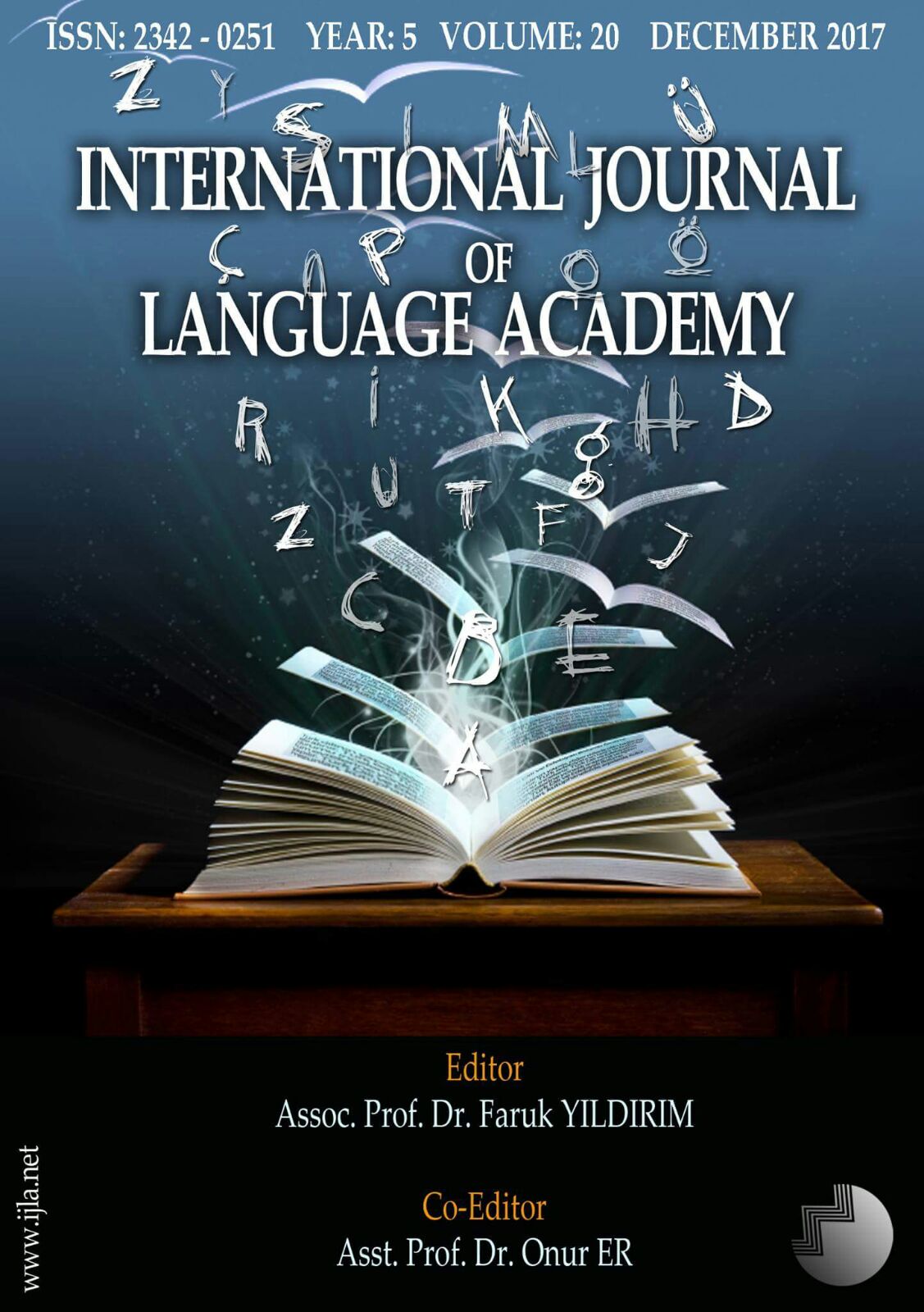Author :
Abstract
Dilbilgisel tanıtsallık, tümcede aktarılan önerme içeriğinin doğruluğuna yönlelik kaynak bilgisinin kodlanmasıdır. Doğrudan (görsel, işitsel ya da duyuşsal) ve dolaylı (çıkarım, varsayım, aktarım) tanıtlar tanıtsallık ulamının alt türleridir.Diller, tanıtsallığı nasıl aktardıkları ve hangi alt ulamları biçimsel olarak işaretledikleri açısından farklılık gösterir. Burada sunulan çalışma da Türkçede tanıtsal anlamları aktarmada kullanılan dilbilgisel belirtilerin aktardığı tanıt türlerini tanımlamayı amaçlamaktadır. Bu çerçevede temel araştırma soruları: i. {-mIş] biçimbirimi, hangi tanıtsal ulamları aktarır?ii. {-mIş] biçimbirimi, diğer eylem çekim ekleri ile birlikte ve tek başına kullanıldığında aktardığı ulamlar farklılaşır mı? iii. Türkçede doğrudan ve dolaylı tanıt alt türleri hangi biçimbirimlerle işaretlenir? Çalışmada, Türkçe anadil konuşucularının hangi biçimbirimler ile hangi tanıtsal ulamların aktarıldığını işaretlemelerini istediğimiz bir sormacadan elde edilen sonuçlar ve bulgular tartışılmaktadır. Sormacaların sonuçları, tanıtsal anlamı işaretlemekle yükümlü tek çekim ekinin {-mIş] biçimbirimi olduğunu kanıtlar niteliktedir. Bu birimin temel işlevi ise dolaylı tanıt türlerini işaretlemektir. Bulgular göstermiştir ki, {-mIş] biçimbiriminin olmadığı tüm tümcelerde bilgi kaynağı konuşucunun kendisidir. İşaretlenen tanıtsal ulam doğrudan tanıttır. Konuşucu tümcede aktarılan önerme içeriğinin kaynağını başkası değil, kendisi olarak sunmaktadır.
Keywords
Abstract
Linguistic evidentiality is the category where the information source is explicitly coded in the sentence. The main types of evidentials are direct evidence (audio, visual, sensory) and indirect evidence (inferential, assumptive, reported/hearsay). Languages differ in how and which evidential types they grammaticalize. Our study presents an empirical work on Turkish evidentials.Our study mainly focuses on the following questions: i.Which evidential meanings are coded with [mIş]?ii.What are the tense, and aspect values coded with {mIş} with and without other verbal suffixes?iii.Which suffixes are used to code direct evidentiality, inference, assumptive and reportative/hearsay in Turkish? The study presents analyses of a series of surveys where native speakers of Turkish are asked to identify the type of evidence coded in the sentences, to identify the tense, aspect and modal values of particular verbal suffixes, and to decide which verbal suffixes are used to code given evidential value to the sentence. The native-speaker test results show that Turkish distinguishes between the direct and indirect evidentials. Our study puts forward that, in Turkish, the one and only grammatical marker of evidentiality is {mIş} with indirect evidential meaning, whereas any aspect marker, i.e. {Iyor}, {DI}, and copula on nominal sentences, may indicate that the speaker is presenting the information from his/her own conscious, i.e direct evidentiality. That is to say, if the sentence is not marked with {mIş} then it is marked with direct evidential no matter which tense or aspect markers are used.
Keywords
- Aikhenvald, A. Y. 2004. Evidentiality. New York: Oxford University Press.
- Aksu-Koç, A. 1988. The Acquisition of aspect and modality: The case of past reference in Turkish. Cambridge: CUP.
- Banguoğlu, T. 1959. Türkçe’nin Grameri. Ankara: TDK
- Bybee, J. ve S. Fleishman 1995. Modality in Grammar and Discourse. Amsterdam: J. Benjamins.
- Cinque, G. 2001. A note on mood, modality, tense and aspect affixes in Turkish. In E. Erguvanlı Taylan (Ed.) Verb in Turkish, 45-59. Amsterdam: John Benjamins.
- Corcu-Gül, D. 2010. Tanıtsallığın Durum Anlambilimsel Sunumu: Türkçede Tanıt Türleri [A situational Semantic Analysis of Evidentiality: Evidentiality in Turkish] Unprinted PhD Dissertation. Ankara University, Ankara.
- Csâto, E. E. 2000. –mIş and –ImIş items. Dimensions of a functional analysis. In U. Bo ve Johanson, L. (eds.) Evidentials. Turkic, Iranian and neighbouring languages, 29-44. Berlin & New York: Mouton de Gruyter.
- Faller, M. 2002. Semantics and Pragmatics of Evidentials in Cuzco Quechua. Unprinted PhD Dissertation. Stanford University.
- Frawley, W. 1991. Linguistic Semantics. New Jersey: Lawrence Arblaum Associates
- Gencan, T.N. 2001. Dilbilgisi. Ankara:TDK
- Göksel A. and C. Kerslake 2005. Turkish: A Comprehensive Grammar. New York: Routledge.
- Gül, D. 2009. Semantics of Turkish evidential –(I)mIş. In Ay, S. & Ö. Aydın & İ. Ergenç & S. Gökmen & S. İşsever & D. Peçenek (Eds.) Essays on Turkish Linguistics: Proceedings of the 14th International Conference on Turkish Linguistics, August 6-8, 2008, 177-186. Wiesbaden: Harrasssowitz
- Ifantidou, E. 2001. Evidentials and Relevance. Amsterdam and Philadelphia: John Benjamins Publishing Company.
- Johanson, L. 2000. Turkic indirectives. In L. Johanson & B. Utas (Eds.) Evidentials: Turkic, Iranian and neighbouring languages (pp. 61-88). Berlin: Mouton de Gruyter.
- Johanson, L. 2003. Evidentiality in Turkic. In A. Y. Aikhenvald & R. M. V. Dixon (Eds.) Studies in evidentiality (pp. 273-290). USA: John Benjamins.
- Kornfilt, J. 1997. Turkish. New York: Routledge
- Lewis, G. 1967. Turkish Grammar. Oxford: OUP.
- Lyons, J. 1977. Semantics, Volume II. Cambridge, Cup.
- Palmer, F. R. 2001. Mood and Modality. Cambridge: CUP.
- Plungian, V. 2001. The place of evidentiality within the universal grammatical space. Journal of Pragmatics, 33. 349-357
- Sezer, A. 1990. A new approach to the conjugation of the Turkish verb. Current issues in Turkic linguistics.
- Sezer, A. 2012. Türkçe’nin Köşeleri. In M. aksan and A. Uçar (Eds.) Proceedings of 5th International Conference on Turkish Teaching, 10-20. Ankara: Şafak Matbaası.
- Sweetser, E. E. 1990. From etymology to pragmatics: Metaphorical and cultural aspects of semantic structure. Cambridge: Cambridge University Press.
- Tura Sansa, S. 1986. DIR in Modern Turkish. In: Aksu-Koç Ayhan, Eser E. Taylan (eds.) Türk Dilbilimi Konferansı Bildirileri, 9-10 Ağustos 1984, İstanbul, 145-158.
- Underhill, R. 1985. Turkish Grammar. Londra: MIT.
- Uzun, N. E. 1998. Türkçede görünüş/kip/zaman üçlüsü. Dil Dergisi, 68. 5-22.
- Uzun, N. E. 2004. Dilbilgisinin temel kavramları: Dünya dillerinden örnekleriyle. İstanbul: Mehmet Ölmez Yayınları.
- Willett, T.L. 1988. A Cross-Linguistic Survey of the Grammaticization of Evidentiality. Studies in Language 12, 51-97.
- Yavaş, F. 1980. On the meaning of tense and aspect markers in Turkish. Unpublished PhD Dissertation, Kansas University.
